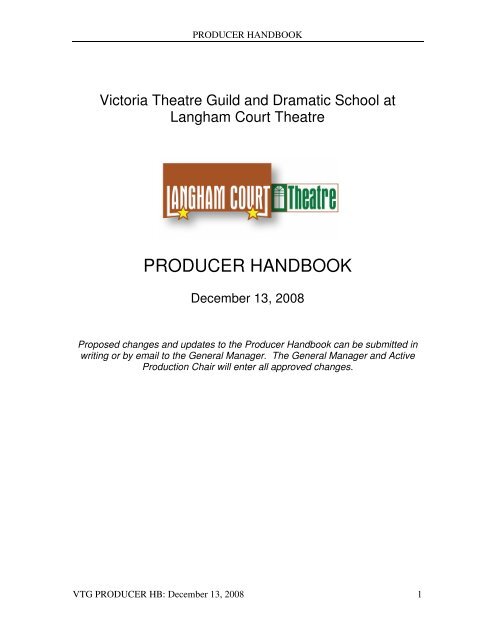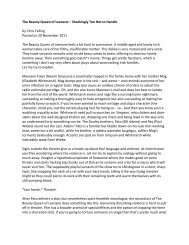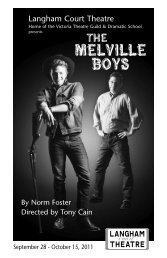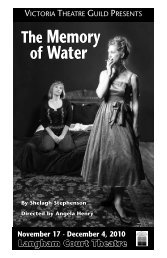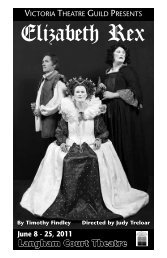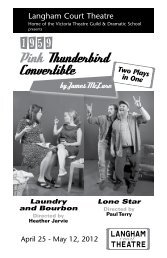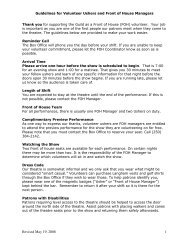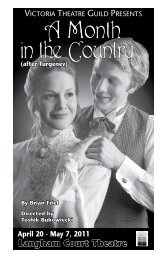PRODUCER HANDBOOK - Langham Court Theatre
PRODUCER HANDBOOK - Langham Court Theatre
PRODUCER HANDBOOK - Langham Court Theatre
Create successful ePaper yourself
Turn your PDF publications into a flip-book with our unique Google optimized e-Paper software.
<strong>PRODUCER</strong> <strong>HANDBOOK</strong>Victoria <strong>Theatre</strong> Guild and Dramatic School at<strong>Langham</strong> <strong>Court</strong> <strong>Theatre</strong><strong>PRODUCER</strong> <strong>HANDBOOK</strong>December 13, 2008Proposed changes and updates to the Producer Handbook can be submitted inwriting or by email to the General Manager. The General Manager and ActiveProduction Chair will enter all approved changes.VTG <strong>PRODUCER</strong> HB: December 13, 2008 1
<strong>PRODUCER</strong> <strong>HANDBOOK</strong>Producer HandbookCONTENTS1. Introduction2. Auditionsa) Pre-Auditionsb) Auditions and Call Backsc) Post-Auditions3. Rehearsals (Production Meetings)a) Regular Agenda Items and Tasksb) Special Agenda Items- Meet and Greet- The Program- Production Seats- Closing and Strike- Photographs for Purchase4. Tech Week and Week-End5. Performancesa) The Runb) Closingc) Strike6. Tools & Templates1 Timelines2 Contact Sheet3 Audition Notice (sample)4 Audition Form5 The Budget6 Meet & Greet Schedule (sample)7 Producer’s Program Check List8. Biography Information Sheet9 Production Seats Sign-Up Sheet10 Tech Week End Schedule (sample)11 Post Production ReportVTG <strong>PRODUCER</strong> HB: December 13, 2008 2
<strong>PRODUCER</strong> <strong>HANDBOOK</strong>1. IntroductionThis handbook has been prepared to help you be a competent and confidentproducer, an effective mentor or learner, and to help you have fun while doingboth. It will guide you, help you solve problems, and save you time (and maybegrief). We want this to be a good experience for you. We want you to happilyproduce shows, again and again.The Producer brings a business perspective to the production and is responsiblefor organizing, supporting, and facilitating the artistic endeavors of the productionteam, cast, and crew. The Producer works collaboratively with the Director andStage Manager to establish the production team, to coordinate the productionprocess, to manage the budget, and to assist, resolve conflicts, and trouble-shootas necessary. (That’s right – if a personality conflict is impeding the artisticprocess, the producer will step in to resolve it. You won’t just ‘let it go’.)A producer requires exceptional organizational and interpersonal skills. Buildinga collaborative, effective, and satisfied team is a producer’s aim.This Producer Handbook should be reviewed with the Director and StageManager very early in the production process, and adjusted in keeping withindividuals’ strengths and preferences, and the vagaries of circumstance.As long as everything gets done, and someone assumes responsibility for eachtask, there is considerable flexibility in who does what. Reviewing theseexpectations early in the process avoids confusion and frustration later. Gapsand overlaps in communications and role expectations are hard on everyoneinvolved with the show. It’s worth the time to have the Director and StageManager review this handbook and have a short meeting about the contents.The same is true for the review of the Stage Manager handbook.Producers are expected to mentor others into the role. We are both a theatreand a drama school. In the event that there is a co-producer, the two producerscan divide the responsibilities as they wish. Or, as an experienced producer, youmight be asked to be a resource person “on call” for another producer involved ina show. This handbook will be a helpful resource in all of those situations.The Active Production Chair is a critical resource for producers as well. They areresponsible for supervising each show of the season and are available to answerquestions, give guidance and direction, and to directly intervene if necessary.Active Production Chairs are there to help you – use them.VTG <strong>PRODUCER</strong> HB: December 13, 2008 3
<strong>PRODUCER</strong> <strong>HANDBOOK</strong>If a review of the Guild’s organization and positions would be helpful (What doesthe GM do? What is an Active Production Chair?), please refer to “Get Involved -Positions Overview” on the web at langhamcourttheatre.bc.caThe goal for everyone is to create an artistically sound production, an effectiveand efficient process, and the good will of all involved. This blending of diversetalents and innumerable hours and effort is the MAGIC of THEATRE! Have fun!2. AuditionsThis phase is initiated by the Director approximately 10-12 weeks beforeOpening. It is characterized by the establishment of the team – the Cast,Production Heads, and Crew. It also includes the development of anenvironment where each team member is appreciated for what they bring to thiscreative process, and where the need to work collaboratively is a shared value.A successful show is a team endeavor!a) PRE-AUDITIONS1. Request from the General Manager (GM) contact information (names,phone numbers, email address) for Volunteer Coordinator, ActiveProduction Chair, Program Coordinator, Bar Manager, Front of HouseCoordinator, Box Office Manager, Web Master, Newsletter Editor,Costume Loft Manager, Photographer, Production Coordinator andFacilities Manager. These are people you, the director, and the stagemanager will have to contact somewhere in the production process. Itsaves time to have this information in one place at the beginning of theshow. Give a copy to Director, Designers and Stage Manager (SM).2. Receive from the Volunteer Coordinator a list of current members andmake copies for Director and SM. The three of you are contactingmembers frequently throughout the production.3. Collaborate with the Director, the SM, Active Production Chair and theVolunteer Coordinator to find Light, Sound, Set and Costume Designers;and Props Manager (These are the Production Heads of the ProductionTeam).4. Aim for the right mix of people considering both experience and personalcompatibility. This is especially true for the Director and Stage Managerwho have to work so closely together, but also true for all members of theProduction Team.5. Assist Designers to find crew to work on the show (operators, assistants,painters, stage crew, seamstresses, hair stylists…) Most designers haveVTG <strong>PRODUCER</strong> HB: December 13, 2008 4
<strong>PRODUCER</strong> <strong>HANDBOOK</strong>lists of people they have worked with before. Other sources of possiblevolunteers include the programs from previous shows, organizations suchas VOS and St Luke’s theatre, local high school drama departments, UVictFine Arts Program, staff, family, and friends. The Volunteer Coordinatorcan also produce a list of previous volunteers who have worked onspecific crew activities. Advertisements for volunteers can be placed inthe theatre Newsletter, the volunteer section of the Times Colonist, andwith the volunteer bureau. Before this task gets desperate, involve theActive Production Chair.6. Produce Contact Sheet (see Tools & Templates 2); send to all involved inthe show and copy GM, Bar Manager, Front of House Coordinator, ActiveProduction Chair (update them regularly). This will prevent cast and crewfrom being called to volunteer as bartenders and ushers. Include on theContact Sheet the phone numbers of the GM, Box Office, Backstage, theActive Production Chair, Production Coordinator, Technical Director,Facilities Manager.7. Have the Director determine audition dates, time, space, and scriptrequirements (full scripts or sides); send information to Newsletter Editorand General Manager (see Tools & Templates 3). The GM will send theinformation to the Web Master.8. Book the rooms (lounge, stage, and/or rehearsal room) for auditions andcall backs on the calendar on the Box Office door. Keeping this calendarup to date avoids double-booking problems.9. Make enough copies of the script or sides for auditions. The scripts are inthe lobby desk drawer and the copy machine is also in the theatre lobby.b) AUDITIONS and CALL BACKSGenerally, auditions occur 8-10 weeks before Opening Night and take place inthe lounge, theatre, or rehearsal room, depending on Director’s preference androom availability.• get the Audition Box from the GM’s Office before setting up thereception space and audition site; ensure good signage to guidecandidates through the theatre• sign out the theatre keys from the GM (for Producer, SM,Designers). See 3 - Rehearsals/a/2 for more information re. keys• welcome each candidate, offer tea/coffee, and ask them tocomplete the audition forms (see Tools & Templates 4) which are inthe Audition Box (Membership Application form, which lists manyvolunteer positions is also in the box).VTG <strong>PRODUCER</strong> HB: December 13, 2008 5
<strong>PRODUCER</strong> <strong>HANDBOOK</strong>• if requested by the Director, assist the Director and SM with castingdecisions and note-taking in the audition roomc) POST-AUDITIONS1. Phone and speak personally to each candidate to ask them to return forcallback or to thank them for auditioning although they haven’t beenselected; do this with great kindness and respect and sensitivity: “Thankyou for coming out for the audition. You did a very good reading. But wehad an exceptionally strong showing and you haven’t been selected for apart in this production. I hope we will see you at <strong>Langham</strong> <strong>Court</strong> in thefuture.”2. Use voicemail only as an extreme measure.3. Pursue a backstage position only if they bring it up at this time. You canalways call them another day when they are feeling less disappointedabout not getting the part.4. After callbacks, phone and speak personally to each callback candidateand offer the role or thank them for auditioning although they haven’t beenselected (see #1 under Post Auditions)5. Add cast to Contact Sheet and forward to cast/crew/Production Heads,GM, Web, Newsletter Editor, Bar Manager, FOH Manager, ActiveProduction Chair, Program Coordinator.6. Work with Director and SM to set Rehearsal Schedule, book rooms on thecalendar of the Box Office door.3. RehearsalsThe Rehearsal phase is approximately 8 weeks before Opening.For the Producer, the Audition and Rehearsal stages are busy with planning andchairing PRODUCTION MEETINGS which can be weekly or as often asnecessary. The Director, Stage Manager, Designers, and Active ProductionChair attend. The Director’s creative vision is shared and the individualdesigners speak to, plan for, and execute their portion of that vision – the set,costumes, light, sound, and props. What will they create to support the vision?How will this all come together for the audience? How can we help one another?How can we stay within budget?VTG <strong>PRODUCER</strong> HB: December 13, 2008 6
<strong>PRODUCER</strong> <strong>HANDBOOK</strong>This talent-meld is a huge portion of The Magic! The Producer facilitates andcoordinates people & activities to enable this meld to occur. Your approachimpacts the emotional tone of the whole team.Another important responsibility during this stage is the preparation of theprogram. This process begins early in the Rehearsal stage and ends 2 weeksbefore Opening.a) REGULAR AGENDA ITEMS & TASKS1. Book the production meeting room, prepare the agenda, chair themeeting, and distribute notes/minutes if necessary2. Distribute keys to Stage Manager and Designers. The Producer hastheatre and office keys. The Stage Manager has theatre keys, rehearsalroom cupboard and booth keys. The Light Designer has theatre andbooth keys. The Costume Designer has theatre and loft keys. In theinterests of theatre security, the producer can issue fewer keys if theyaren’t necessary. Similarly, if more are needed the producer will requestthem from the GM. The producer is responsible for collecting the keysand returning them to the GM.3. Receive from the GM further rules & policies requiring distribution to theProduction team via Production Team Meetings or emails.4. Be inclusive, set a positive tone, and be efficient at the meetings; theyusually last one hour5. Encourage designers and their crew to attend the Read Through (the firstreading of the entire script by the selected cast); it’s a good chance forcast and crew to meet, and for crew to get “a feel for” the play. (Modelsand initial renderings of lights, set, and costumes may be available then)They are also welcome to attend any rehearsal. The more familiar theyare with the play, the easier Tech Week-End will be.6. Monitor staffing issues regularly:• Do the designers have enough help? (see Pre-Auditions, #5)• Are the volunteers members of the Guild? (have membershipapplication forms ready; they are available in the lobby or from BoxOffice Manager); everyone involved in a show is to be a Guildmember as per the Constitution and By Laws (This fee collectingresponsibility may shift to the Membership Chair if the position isreinstated)• Are volunteers being oriented/mentored adequately? We are aDrama SchoolVTG <strong>PRODUCER</strong> HB: December 13, 2008 7
<strong>PRODUCER</strong> <strong>HANDBOOK</strong>7. Have every Production Team member “report in” or give a design “update”at each meeting. It’s this ongoing dialogue that prevents a set fromblocking lights, lights from altering the color of costumes, and upholsteryfrom clashing with the color of walls. Direct people to meet separately ifthe whole group is not needed for the problem-solving. e.g. director andcostume designer can meet separately re. the suitability of specific outfits.Stay current with design progress with between-meeting contacts withdesigners. This is critical leading up to Tech Week End.8. At an early Production Meeting, have each designer estimate their costsand remind the team that the Production budget is $3000. (see Tools &Templates 6) Hopefully their estimates are within that limit. Their estimatesformulate the Preliminary Budget which is submitted to GM. Havedesigners update their actual expenses to their estimated costs regularlyat meetings so everyone can monitor the budget. And remind everyoneoften to keep their receipts which are necessary for a reimbursement.9. Develop a system for tracking expenses per account: set, costumes,props, light, sound, miscellaneous; and develop a system for tracking cashadvance expenses (see Tools & Templates 6)10. Ask the director if he/she wants a directors’ night when select directors areasked to attend a rehearsal and to offer feedback on specific aspects ofthe show or to offer feedback in general; if so, invite those directors toattend11. Ask the cast to loan the <strong>Theatre</strong> Archivist photos from other shows they’vebeen in. He may use them in his hallway photo gallery during the run.12. Schedule tech and stage crew rehearsals if director deems themnecessary13. Attend as many rehearsals as possible, at least once a week, to monitorprogress, liaise among actors & production team, anticipate needs,prevent crisis, resolve conflicts, assist and trouble shoot as necessary.14. Keeping in mind that 2 productions occupy the theatre at any give time,communicate with the producer/SM of the other show as necessary re.important dates, use of space, security systems, contact information etc.15. Should a conflict occur, the show on stage is the show that takes priority inscheduling.16. Get the date & time for the other show’s Strike and ensure your cast/creware there to help. The other show which has completed its run is givingyour show the stage and dressing rooms. Your show is passing on theVTG <strong>PRODUCER</strong> HB: December 13, 2008 8
<strong>PRODUCER</strong> <strong>HANDBOOK</strong>rehearsal room to the incoming production. (See Strike section underPerformances)17. Be aware of other processes that may impact the production team. Forexample “The writing of the Introduction to the Play”. See other positionguidelines in the Handbooks section of the web.b) SPECIAL AGENDA ITEMS1. Meet and GreetThe Monday following the previous show’s Strike, a Meet and Greet isscheduled. All cast and crew and Board members are invited. <strong>Theatre</strong> staff andnew members who are curious about the theatre have been invited as well.The Board officially welcomes the production team to the theatre; each personintroduces themselves and indicates their involvement with the production; and apotluck dinner is shared. Everyone should be made to feel most welcome. Keepthe “social” up and the “business” down as much as possible. Much “business”information can be passed on with group emails. This event includes professionalphotographs being taken: headshots of Director, Stage Manager, Producer,Designers, Cast; scene photos which will be used for publicity; and one groupphoto of everyone involved in the show. A regular rehearsal might follow theMeet and Greet.1. Schedule the Meet and Greet in collaboration with the Director and StageManager - the date, and the timing of the photographs, the circle &introductions, and the dinner (see Tools & Templates 6)2 Book the lounge on the calendar on the office door, invite Board membersand the GM, alert all members of the production team, cast and crew. TheGM will invite the <strong>Theatre</strong> Team.3 Ask all members of production team, cast and crew to bring something forthe potluck dinner4 Get the Headshots File from the GM and determine what headshots are tobe taken. Head shots taken within the past 3-4 years are considered currentand will not be redone. Advise those having headshots taken to wear darkclothing with sleeves.5 Provide the GM with the Meet and Greet schedule. The GM will book thephotographer.6 Ask Director which publicity shots they want and inform costume designer;book hair stylist if necessaryVTG <strong>PRODUCER</strong> HB: December 13, 2008 9
<strong>PRODUCER</strong> <strong>HANDBOOK</strong>7 The GM will book the Bar Manager to have the bar open8 Arrive early to arrange chairs in a circle, put tablecloths and utensils onfood tables, assist the photographer as necessary. (additional chairs are inthe back closet of the lounge by the exit; disposable dishes andtablecloths are in the cupboard near the unlocked fridge)9 Chair/Host the Meet and Greet. Make people feel welcome and have fun.Coordinate the Clean Up.2. The ProgramThe development of the Program is a prime example of collaborative team effortthat includes persons from outside of the theatre. The program is professionallyproduced under contract with Victoria Arts Marketing. Their timelines are tightand everyone has to do their part, well, and on time. The Producer initiates thisprocess with the Program Coordinator early in the Rehearsal Stage. The aim is tohonor everyone who has had a part to play in the production, and to produce aquality program for our audiences. The Producer Program Checklist (Tools andTemplates 7) is very helpful.1. Give the Bio Forms (electronically and/or hard copy) to cast andproduction heads at least 6 weeks before Opening. (see Tools &Templates 8) If you have a very large cast and crew, remind the ProgramCoordinator now because this will significantly impact program layout.Remind production heads and cast that late bios result in a photo but notext appearing in the program. Individuals email their bios as anattachment to the Program Coordinator who will edit for spelling, grammar,and length.2. Ask the Director to prepare and submit to Program Coordinator theDirectors Notes, Description of Scenes for each act, and Author bio3. This is a good time to get posters from GM for posting and distribution.4. The headshots and audiotape identifying the currently photographedheadshots will be sent from the photographer to the Victoria ArtsMarketing. The producer will send headshots taken within the past 3-4years to Victoria Arts Marketing.5. Work with designers to keep an ongoing list of people/places who haveassisted with the show in order to include in the Acknowledgements6. Work with designers to keep an ongoing list of their crew to include in theprogramVTG <strong>PRODUCER</strong> HB: December 13, 2008 10
<strong>PRODUCER</strong> <strong>HANDBOOK</strong>7. The producer is responsible for proof-reading the program. The first draftcomes to the theatre from the program coordinator and ideally gives timefor people to proof-read their contributions; the second proof-read occursat Monday Magazine office and is completed by the Producer.3. Production SeatsFor the Preview and for each Performance, 3 seats are reserved for members ofthe production team, cast, and crew. They are P1, 2, and 3 in the back row of thetheatre. The director has first choice and usually signs up for Opening andClosing. (see Tools & Templates 8)Approximately 3 weeks before Tech Weekend, post the production seat sign upsheet. The Box Office Manager will give the producer the tickers. If you have avery large cast and crew, consult with Box Office Manager early regarding how toaccommodate the numbers of people.At production meeting and rehearsal, or through group email, alert ALLproduction team members, cast, crew that the sign up sheet is posted on thebulletin board at the foot of the Costume Loft stairs. Remind them not toapproach the Box Office for additional seats.During Tech Week End, distribute tickets to those who signed up for them, ByPreview Night, return undesignated tickets to the Box Office for sale to the public.4. Closing and StrikeArrange for the Closing Party to be at the theatre or at someone’s home. Inviteeveryone involved in the show. Arrange for a production team/cast/crew potluckand the production budget contributes $50 as well. (See Tools & Templates 5)Confirm with the Head Set Builder what time the Strike will begin the Sundayafter closing. Inform your cast and crew, and the Producer of the next show.Everyone from both shows is required to assist with the “handing over” of thetheatre stage and spaces. (See Strike section under Performances)5. Photographs for PurchaseFrom the many photos the photographer has taken, copies will be madeavailable for cast and crew to purchase.• the photographer will send contact sheets, order forms and instructionsto GM; The GM will put the package in the Green Room and notify theproducer that the package is there• producer will email cast and crew to let them know of the opportunity andthe deadline to orderVTG <strong>PRODUCER</strong> HB: December 13, 2008 11
<strong>PRODUCER</strong> <strong>HANDBOOK</strong>• return contact sheets and order forms to the “current production file” bythe deadline, and let photographer (cc GM) know they are ready for pickup (remind photographer of current office hours to avoid an unnecessarytrip)• the photographer will develop the photos and try to have them back inthe “current production file” before Closing; he will let the GM know theyare there, GM will notify producer who will advise cast and crew to pickup their photos4. TECH WEEK AND WEEKENDThe light and sound designers and their crews take at least the week before TechWeekend to prepare for it. The Light Designer and light crew hang and focus thelights, cut gels, run cables and program the light (LX) board. The SoundDesigner and crew record music and sound effects, and program the sound (SX)board. The light and sound operators will be trained by the Designers beforeTech Week-End.Tech Week-End is the last weekend before Opening.This is it. Tech Week-End is the marriage of the acting, the lights and the sound.The set and the costumes are complete at this point as well. All the light andsound cues are “set” with the script and practiced (Cue to Cue). Levels areadjusted and set. The weekend is long (Fri evening, Sat, Sun) and laborintensive. (See Tools & Templates 10) A potluck dinner is shared Sundayevening and the weekend concludes with a Tech Run – a rehearsal with allaspects included.1. 3-4 weeks before Tech Week End, arrange for a cast/crew potluck for theSunday night dinner. (The Light Designer will have ordered pizza for theHang & will give receipts to you)2. Three weeks before Tech Week End ensure light and sounddesigners will be ready for it: design, cue sheets, enough crew andtrained operators who are familiar with the play3. Stage crew and costume dressers might be needed for the tech run; workwith SM to ensure they are at Tech Week End4. Assist Director and Designers as necessary during Tech Weekend (levels,cue to cue, tech runs)5. Coordinate serving the pot luck dinner and it’s clean upVTG <strong>PRODUCER</strong> HB: December 13, 2008 12
<strong>PRODUCER</strong> <strong>HANDBOOK</strong>5. PERFORMANCESPreview Night is the Wednesday before Opening Night on Thurs. It’s a finalDress Rehearsal with a paying audience!Opening Night on Thurs is followed by a light reception, and is often the nightwhen reviewers are in the audience.The theatre is dark Sunday and Mondays.The afternoon matinees are on the last two Saturdays at 2 pm.Counting Preview Night, the show is performed for an audience 16 times in a 3week period. The Director may be in the audience once or twice, but the show isnow in the hands of the Stage Manager. The Producer responsibilities arelimited during the Run and producers are free to volunteer as stage crew,dressers, or Front of House personnel.a) The Run1. On Opening Night it is customary for the Producer to give tokens of thanksto the cast and crew. This can be in the form of cards, food, or personalgood wishes to Break A Leg!2. The photographer usually returns on the Friday after Opening Night totake the Archival photos. The Director will have pre-determined whatshots they will be. This is part of the photographer’s contract and isbooked by the GM.3. If many cast/crew are staying at the theatre between the matinee andevening performances (many choose to go home or to go out), they areasked to bring their own dinner which can be augmented by the productionbudget. (See Tools & Templates 5)4. Sometime during the Run, remind cast and crew about their attendance atthe Strike.b) Closing1. Get the place ready for the party if it is at the theatre. Have fun and leadthe clean-up.c) StrikeAll Cast and Crew of the show, plus the cast and crew of the next show, arescheduled on the Sunday morning after Closing to dismantle the set, returnVTG <strong>PRODUCER</strong> HB: December 13, 2008 13
<strong>PRODUCER</strong> <strong>HANDBOOK</strong>costumes to the loft or to the drycleaners, return props to the prop room or to thelenders, and clean the dressing rooms and green room. That is, all remnants ofthe show are removed from the theatre and the next show assumes possessionof the stage.1. Assist with whatever work needs to be done: sets are taken down,destroyed/disposed of, put away; stage, wings, booth, and rooms arecleared and cleaned2. Work with Designers and SM to ensure all borrowed items are returned torightful places and persons; costumes are laundered/dry cleaned beforereturn to the loft3. Collect and return keys to General Manager4. Prepare the Post Production Report (see Tools & Templates 11) and FinalBudget Report (see Tools & Templates 5). Submit both to ActiveProduction Chair. Submit copy of Final Budget Report to GM. RemindSM and Director that they can complete a Post Production Report as well,and provide them with a copy of the form.6. TOOLS & TEMPLATES1. Timelines2. Contact Sheet3. Audition Notice4. Audition Form5. The Budget6. Meet and Greet Schedule7. Producer’s Programme Check List8. Biography Information Sheet9. Production Seats Sign-Up Sheet10. Tech Weekend Schedule11. Post Production ReportVTG <strong>PRODUCER</strong> HB: December 13, 2008 14
<strong>PRODUCER</strong> <strong>HANDBOOK</strong>TOOLS & TEMPLATES #1TIMELINESACTIVITY DURATION ACTIVITY& OCCURRENCEAUDITIONS 2-4 WEEKS Establish production team, cast,and crewREHEARSALS 8-10 WEEKS Regular Production MeetingsAssist with previous show’s StrikeMeet & Greet, PhotosMove to Stage for RehearsalsMeet Program Deadlines for bios(4 wk before Opening), then therest of the program (2 wk beforeOpening)Sign up for Production SeatsPurchase PhotographsTech Week & Week End (weekend before Opening)PERFORMANCES 3 WEEKS Wed – PreviewThurs – Opening14 performances including 2matineesSat –ClosingSTRIKE 1 DAY The Sunday after ClosingPrepare Budget & Post-ProductionReportsVTG <strong>PRODUCER</strong> HB: December 13, 2008 15
<strong>PRODUCER</strong> <strong>HANDBOOK</strong>Commitment to a show can be of 13-17 weeks duration, sometimes longerdepending on the Director and the selected play.VTG <strong>PRODUCER</strong> HB: December 13, 2008 16
<strong>PRODUCER</strong> <strong>HANDBOOK</strong>TOOLS & TEMPLATES #2YOUR PRODUCTION NAMECONTACT SHEETUpdated on DATERole Name Phone EmailVTG <strong>PRODUCER</strong> HB: December 13, 2008 17
<strong>PRODUCER</strong> <strong>HANDBOOK</strong>TOOLS & TEMPLATES #3AUDITION NOTICE (sample)Send to Newsletter Editor, General Manager“Waiting in the Wings” by Noel CowardDirector: Roger CarrAudition Dates: Saturday Oct 28 10-4 and Sunday Oct 29 10-4Production Dates: Jan 8 – 25Cast Required: 14 women, 3 men10 women have to be able to play 60 or over1 woman in her 50s2 women in their 30s1 woman in her 20s3 men of various agesFor breakdown of roles, please read the director’s notes posted on the NoticeBoard at <strong>Langham</strong> <strong>Court</strong>.Scripts are available for sign-out in the theatre lobby. Cost to non-membersis a refundable $10.VTG <strong>PRODUCER</strong> HB: December 13, 2008 18
<strong>PRODUCER</strong> <strong>HANDBOOK</strong>TOOLS & TEMPLATES #4AUDITION FORMName: ______________________________________________Address: ________________________________________________________________________________________________Phone ( Home): ____________________ Cell: ______________Work: _____________________ May we call work? Yes NoE-mail: ________________________________________Are you presently a member of the Victoria <strong>Theatre</strong> Guild? Yes NoAre you presently a member of the Canadian Actor’s Equity YesNoYou must be available for all 16 performances including the preview night. Thereare no shows on Sunday or Monday. Evening performances are at 8pm. Matineeperformances are at 2pm on the second and last Saturday of the show run. Youmust also attend the strike of the set after the close.Previous Experience:1. ___________________________________________________________2. ___________________________________________________________3. ___________________________________________________________4. ___________________________________________________________5. ___________________________________________________________VTG <strong>PRODUCER</strong> HB: December 13, 2008 19
<strong>PRODUCER</strong> <strong>HANDBOOK</strong>If you are not cast would you be interested in working backstage and/or in takinga walk-on role? Backstage: Yes No Walk-on: Yes NoI agree to become a member of the Victoria <strong>Theatre</strong> Guild on or before the firstread-through if I am accepted in the Production Team (actors, crew, designers).Failure to do so may result in re-casting.Signature: _________________________ Date: _________________As a result of increasing concerns about copyright laws and performers’ rights, theVictoria <strong>Theatre</strong> Guild has added this legal clause to our audition forms to clarifyeveryone’s rights.Translation of the legalese below: You give us permission to take your picture includingvideotape and/or DVD and use it for the show (for programs, publicity, archives, etc.).You can use the pictures we take of you for other things. We own the rights to the actualproduction.PERFORMER’S RELEASEIf I am cast in this production (the ‘Production’) I,______________________________hereby give the Victoria <strong>Theatre</strong> Guild and Dramatic School (the ‘Guild’), its successors,assignees, licensees and any agent of the Guild, all rights in and to all poses, acts, playsand appearances made by me for the Production, as well as the right to use my personathrough any indicia or identifying characteristics including my name, visual image ordepiction and voice, for archival, commercial, educational, promotional and informationalpurposes worldwide. I further give the Guild the right to reproduce in any manner anyrecordings, including photographs and video, made by or on behalf of the Guild of myvoice and physical likeness.I further agree that I shall have no right, title or interest in or to the Production, anyrecordings of the Production, or any revenues derived from their exploitation.SIGNED and DELIVERED by: _____________________________ (Performer)on the ______ day of ____________________ 20___ in the presence of:______________________________________________________(Witness – sign and print name)If the performer is under 19 years of ageI confirm that as the parent/guardian of _____________________(Performer)I have read and understood the above release prior to signing it and agree to be boundby its terms.SIGNED and DELIVERED by: _____________________________(Parent/Guardian) on the ______ day of ____________________ 20___in the presence of: ______________________________________________________(Witness – sign and print name)VTG <strong>PRODUCER</strong> HB: December 13, 2008 20
<strong>PRODUCER</strong> <strong>HANDBOOK</strong>TOOLS & TEMPLATES #5THE BUDGETThe Board of Directors has set a maximum budget of $3000 for each productionand the Producer is responsible for administering it. If you are producing for thefirst time, the budget may be something to discuss with an experienced producer.The Producer will ask Designers to estimate their budgets based on perceivedneeds for fabric, lumber, paint, unusual props, etc; will monitor expenditures atproduction meetings and if necessary, ask for cost-cutting measures.If an over-budget is anticipated, this will be discussed with the Active ProductionChair and if necessary, a presentation can be made to the Board to itemize theneeds of the production.Similarly, if there is an unusual request for money – such as a very expensivepiece of equipment that will stay with the theatre, or a request to pay anhonoraria to an operator – inform the Active Production Chair who will seekpermission from the board. (Note that if the Active Production Chair is a memberof your theatre team, you will inform/consult with the Planning Production Chairinstead)The general approach to expenditures is to borrow from members, friends,commercial enterprises, and other theatres; to buy inexpensively at consignmentstores and discount outlets; and to make from materials at hand. The word“prudent” should come to mind.The Producer can get a cash float of $350 or more from the General Manager toreimburse small expenditures which have been verified by a receipt. For largerexpenditures such as set building, the theatre has accounts with a number ofsuppliers and charges for such things as lumber and paint might be shared bythe production and the theatre. Discuss bookkeeping for this with the Facilitiesand Maintenance Manager if it applies to your show.A suggested record-keeping approach is to have a page and envelope for eachcost-centre to record their expenditures & store their receipts: Costumes, MakeUp/Hair, Lights, Sound, Props, Set Building/Painting, Set Décor, Miscellaneous(food, etc).VTG <strong>PRODUCER</strong> HB: December 13, 2008 21
<strong>PRODUCER</strong> <strong>HANDBOOK</strong>Each page is simple : date, item, amount.Sample: Waiting in the Wings……………..COSTUMESJan 12 Value Village 61.48Feb 2 WIN 12.58Designers (Cost-Centre Managers) can give the producer their recordsperiodically for reimbursement, or at the end of the Run. They’ll report regularlyon their expenditures at Production Meetings.Another page is required to account for cash advance expenditures: Date, item,amount and balance. The producer manages the record-keeping for the cashadvances.Sample: Waiting in the Wings……………CASH ADVANCESJan 16 Cash Advance 350.00Jan 17 Props ($50) 300.00Jan 18 Lights ($50) 250.00The final budget report will be a summary of cash advances expenditures, plus asummary of costs by cost-centre. A copy will be sent to Active Production Chairand to GMSample: Summary - Total Cash Advances 790.00Jan 29 Advances 790.00Costumes 200.00Props 300.00Lights 50.00Misc (with receipts) 200.00Balance 40.00Sample: Summary - Costs by Cost CentreCostumes 743.89Props 397.26Lights 72.75Set 618.91Misc (with receipts) 291.78Total Costs for Show 2124.59The designers record-keeping pages will be appended to the final report.VTG <strong>PRODUCER</strong> HB: December 13, 2008 22
<strong>PRODUCER</strong> <strong>HANDBOOK</strong>The Producer is NOT responsible for budgeting for the following: Advertising,Photography, Posters, Program, Royalties and Script, Traffic Controller.Note about Food and Food Expenditures:Each production has approximately $260 for food. The following are approximateguidelines (use your discretion) and are accounted for as “miscellaneous”.Meet and Greet – potluck and cash bar (tea, coffee, beer, wine, pop)Tech Week – Light Hang Pizzas $40Tech Week End - Potluck plus $50Two Matinees – Own food plus $60 if many are staying at the theatreClosing Party – Potluck plus $50The theatre provides coffee, tea, sugar and milk for rehearsals. It does notprovide specialty tea, cookies or snacks.VTG <strong>PRODUCER</strong> HB: December 13, 2008 23
<strong>PRODUCER</strong> <strong>HANDBOOK</strong>TOOLS & TEMPLATES #6MEET AND GREET SCHEDULE (sample)Monday evening in the theatre lounge4:45 SM & Producer open theatre and prepare space for circle of chairsand potluck dinner tables. Set out food as it arrives.5:00 Photographer arrives and sets up locations for shoot.Head & Shoulders before 5:305:30 Cast in costume, hair, make up6:0 Publicity Shots and cast/crew Group Shot6:30 Meet and Greet: each person introduces self and their associationwith the play or their interest in the theatre8:00 RehearsalVTG <strong>PRODUCER</strong> HB: December 13, 2008 24
<strong>PRODUCER</strong> <strong>HANDBOOK</strong>TOOLS & TEMPLATES # 7<strong>PRODUCER</strong>’S PROGRAMME CHECK LISTIt is the producer’s responsibility to ensure that the cast and production heads submittheir BIOGRAPHIES to the programme coordinator FOUR WEEKS before the opening ofthe play. No changes to the biographies will be considered after they are submittedexcept for error correction.The deadline for the theatre to submit the FIRST DRAFT OF THE PROGRAMME to theprogramme coordinator is TWO WEEKS before the opening of the show. Typically,some information is not known at that time (e.g., lighting operators, dressers) but themajority of the programme information is required for the first draft.The first draft is returned to the theatre for proof-reading and final insertions. Once thefinal changes have been made, the producer delivers the programme to the publisher’soffice for final printing. NO changes can be made after this point.The following information is required for the programme:Contact sheet listing all production heads, cast and crew and their positions orroles. (It is most important that the programme coordinator receive this informationas soon as is possible.)Director’s NotesProductions heads and bios (director, SM, producer(s), designers, props manager)Cast and bios and roles in the order you wish them to appear in the programmeDescription of scenes for Act I and Act IIRunning crew (names of stage crew, costume and props assistants, sound andlight crew and ops, set builder, painters – no bios or photos required)Acknowledgements (this is usually only the name(s) of a person or organization)Art show artist(s)’ name and bio (this information is obtained from the art showcoordinator)Non-profit organization name and brief description of their function (obtained fromthe GM) [NOTE: artists and non-profit info combined should be approx ½ page]About the playwright (1/2 a page)VTG <strong>PRODUCER</strong> HB: December 13, 2008 25
<strong>PRODUCER</strong> <strong>HANDBOOK</strong>TOOLS & TEMPLATES #8BIOGRAPHY INFORMATION SHEETPRODUCTION: ________________________________________Biography Information Sheet for:Name: ________________________________________________Role: ________________________________________________Phone: _______________________Fax: ____________________Email: ___________________________________Deadline: [4 weeks before opening night] ______________________Cast and Production Heads:Please write a paragraph about yourself using full sentences in the third personusing no more than 75 words. You may include other roles you have had at<strong>Langham</strong> or elsewhere and/or write something about your background, day job,interests or share an interesting detail about yourself and/or the best part ofworking on this show. I will edit for spelling, grammar and length.Please email at your earliest convenience before the deadline tolindabillings@shaw.caThank you for your prompt attention to this matter.Regards and best wishes for a successful performance.Linda BillingsProgramme Coordinator, <strong>Langham</strong> <strong>Court</strong> <strong>Theatre</strong>(250) 220-4686VTG <strong>PRODUCER</strong> HB: December 13, 2008 26
<strong>PRODUCER</strong> <strong>HANDBOOK</strong>TOOLS & TEMPLATES #9PRODUCTION SEATS SIGN UP SHEETThere are THREE production seats available for the use of cast and crew eachnight during the run of a show. Please sign up below. The director has first optionfor two seats Opening and Closing nights. It is preferable that at first you sign upfor one seat only so that other cast and crew members have a chance at aproduction seat.Please Note: Production seats are the responsibility of the producers and arenot handled by the Box Office.PLEASE SIGN YOUR NAME BELOW TO THE TICKET YOU WANT.DATE P1 P2 P3Preview: WedOpening: ThursFridaySaturdayTuesdayWednesdayThursdayFridaySat matineeSat eveningTuesdayWednesdayThursdayFridaySat matineeSat eveningVTG <strong>PRODUCER</strong> HB: December 13, 2008 27
<strong>PRODUCER</strong> <strong>HANDBOOK</strong>TOOLS & TEMPLATES #10TECH WEEKEND SCHEDULE (sample)Day and TIME ACTIVITY PERSONS REQUIREDFri 7-10 pm Tech – set levels SM, ASM, Stage Walkers, Lighting &Projection CrewSat 9-12 am Light, Sound Cues Light and Sound Board OpsSat 1-4 pm Cues with set Add Stage CrewSun noon Q to Q All Cast and CrewSun 5 pm Potluck Dinner All Cast and CrewSun 7-10 Tech Run All Cast and CrewVTG <strong>PRODUCER</strong> HB: December 13, 2008 28
<strong>PRODUCER</strong> <strong>HANDBOOK</strong>TOOLS & TEMPLATES #11POST PRODUCTION REPORTPlease complete and return to Production Chair. Use the back of this page or addmore pages as needed.Name: ______________________________Show Name: __________________________Phone: _________________Dates: __________________I was the ( one): Producer: ____ Director: ____ Stage Manager: ____Do you wish this report to be kept confidential by the Board? Yes: ___ No: ___1. Comments about production personnel (cast, crew, designers, etc.)2. Comments about production areas (set, lights, props, costumes, sound, publicity,etc.)3. Best part of my experience on this production was:4. Something that would have improved my experience on this production is:5. Recommendations:6. General Comments:VTG <strong>PRODUCER</strong> HB: December 13, 2008 29


